We use cookies to ensure that we give you the best experience on our website. If you continue without changing your settings, we will assume that you are happy to receive all cookies on the Business Car website. However, if you would like to, you can change your cookies at any time

The start point for the best source of fleet information |
Final report: Vauxhall Mokka-E long-term test
Date: 12 July 2022 | Author: Guy Bird
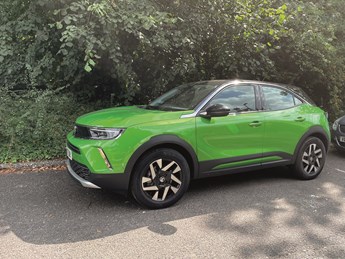
|
|
||||||||||||
Final Report: Mokka-E gets green light
Some long-term test cars live longer in the memory than others and the Mokka-E will be one of those for us. Stand-out design, a full-electric powertrain, right-sized for the city and easy to drive and live with, it's been a hit with a variety of drivers and passengers. And in bright metallic Mamba Green you'll never lose one in a car park.
Drilling down into the costs, as a full EV, the Mokka-E benefits from super-low BIK - 1% when we started and still only 2% this tax year - plus zero first-year road tax and great-value running costs. In nine months we've managed to charge mostly at my neighbourhood lamp post 50 metres from my house for 0.24kWh (via Ubitricity/Shell). Charging an EV with a 201-mile official range means frequent plug-ins, but with a use case of frequent, mainly short trips, our overall 3.3 miles per kWh hour average stayed refreshingly close to the official 3.6mi/kWh. In colder winter months, it dropped to a 2.4mi/kWh low, but during pleasant autumn and spring months topped 4.0mi/kWh.
During our tenure we also tested the closest petrol-powered Mokka relative but found the Mokka-E to be quicker, more controllable and more serene when cruising - with only a 40-litre luggage space penalty to pay. True, the Mokka-E has a higher list price - reduced by Vauxhall by £3000 to £31,580 in December 2021 to still qualify for the new lower threshold Plug-in Car Grant (PiCG) - but its in-use running costs remain its trump card and offset that initial outlay. To take two highlights, our fuel log suggests under £300 spent on nearly 4000 miles (or 13ppm) without factoring longer ownership savings from much lower EV servicing and maintenance costs which, Vauxhall says, equal £478 (£639 vs. £1117).
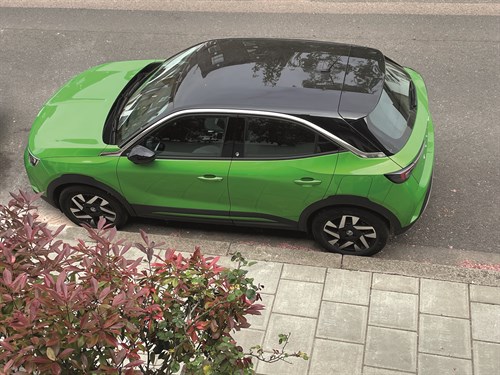
Downsides? At 4151mm long, 1791mm wide and 1531mm high, the Mokka-E is a small crossover (4cm shorter than a Kia e-Soul). So it's great to navigate and park in city streets, aided by an excellent panoramic great rear-view camera standard on the Elite Nav Premium Auto equipment grade. However, those small dimensions translate to a pokey rear passenger space - both to access and sit in. My 6ft 3" football buddy 'Dutch Ben' combs the ceiling with his the head and catches his elbows on the doors. Safe to say he prefers the front. Boot space ranges from a fairly small 310 litres seats up, to a decent 1,060 litres seats down and also has two height options which we either have 'up', to hide the helpfully long re-charging cables, or 'down' when we have bulkier stuff to carry. The 10ins NaviPro touchscreen can be slow-to-react, which is frustrating - do as much address and other inputting before you start to stay calmer - the ride quality is below-average for a small family crossover, especially over potholes and robust speed bumps, and the interior door handles are poorly positioned and/or lack lighting to find easily. Numerous passengers have failed to locate them in the dark.
To drive, the Mokka-E's 136hp (100kW) motor provides useful instant and linear power, and with B button pressed and Eco mode enabled, decent re-generative braking to divert power back to the 50kWh battery. But is the 201-mile range enough (or even the 210-mile figure quoted on later tweaked models)? For our life, 90% of the time, yes. When going on 150-plus round trips without easy charging at the 'away end' military planning is required - but that's more the fault of the currently patchy UK charging infrastructure, not Vauxhall's. Would I recommend a Mokka-E to compact families doing a circa 5000-mile annual mileage without home charging facilities and who want to go green? Again a resounding 'Yes' (and why not choose the £650 mamba green paint to shout about it).
8th Report: Economy gains
Although it's been a cold end to the week as I write, mid-March and indeed early April showed signs of Spring warmth and optimism that are backed up by our Mokka-E's recent economy figures. The latest fuel figure is a healthy 3.7 miles per kilowatt/hour compared to this model's official 3.6mi/kWh and two out of the last three 'fill-ups' have been similar, suggesting it's no flash in the pan, perhaps because the warmer ambient air temperature is allowing this EV to work nearer to its optimum.
In terms of journey type, beyond its frequent short suburban London commutes, the Mokka-E has been down to Brighton on a family visit and up to Coventry on a work-related mission. The coast-bound destination is a 130-mile round trip from south London, and although technically possible with our Mokka-E's 201 mile range (the 2022 version with new tech tweaks claims 209 miles) we did investigate charging in Brighton. Upon arrival we were happy to find that the undesignated parking space by our pre-targeted lamp post charger was indeed free, especially so, because despite starting with a fully-charged vehicle, after 65 miles driven, only 93 miles of range was showing on the digital display.
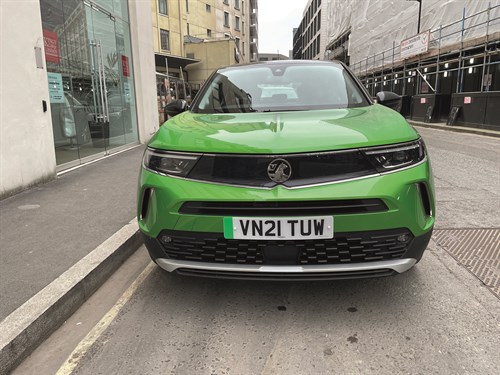
The weight of three adults and one teenager on board won't have helped, but we rarely went at 70mph and tried to stick at 50-60mph for most of the journey. Having downloaded the app and uploaded credit card details for that particular charging post provider in advance, the process was fairly straightforward. But despite the car display clearly showing the charging process had started, the charging app showed an error message, which was disconcerting. Anyway, we left it plugged in and hoped for the best. Checking Vauxhall's separate app once or twice during the day confirmed that charging was indeed still happening and six or so hours later we returned to find 100 or so miles of range added (and to date, no charge levied).
The 200-mile Coventry round trip definitely required a charging session to complete it and although only a two-man operation, one of those men was a photographer with two heavy bags of equipment. The imposition of 50mph limits for sections of the M1 made retaining range easy enough and again, we identified in advance two 50kW chargers right next to each other a mile from our destination. Upon arrival, with 40-odd miles left, one bay was free - after a local shopper with their non-electric car vacated. The first charger failed to connect digitally, so we reversed into the space behind and tried there, which also didn't work, before trying again at the first one and finally succeeding after a 10-minute chat to the charging provider's helpline. 48 minutes after that we were 93% full, but despite building in time for plugging in, this to and fro made us need to push back our meeting by 40 minutes.
Luckily, the meeting was movable and the rest of the day went well, but the scenarios described are not uncommon and help illustrate why longer-distance EV business driving is not without its pitfalls in 2022. The sooner this gets easier, the better. Despite all of that, I'm still loving the Mokka-E and its design threw up another hidden positive the other day after the wind and rain had finished depositing Saharan sand storm over wide section of England: now we know the car's closed-front grille not only looks cool but is much easier to jet-wash clean and wipe down after than an open-grilled combustion engine. Bonus!
7th Report: Petrol versus electric
At a time when many consumers are considering an electric car for the first time, it is not only interesting to consider the differences in various models by different brands, but also the many carmakers that offer both petrol or full-electric powertrains within one model range. So we did.
Having driven the 136hp Mokka-E for more than six months, we are used to its quiet, smooth and instant power and with the "B" button pressed most of the time, also the feeling of control that re-gen braking brings. Jump into the similarly-powerful 130hp 1.2 turbo auto and after taking your foot off the accelerator, the petrol Mokka gives a sensation of running away with itself. The petrol 1.2 is not as quick with your foot on the gas either, taking 9.2 seconds to 0-62mph (versus the E's 8.7).
The three-cylinder petrol engine is also much noisier; a pleasant enough thrum in the old days perhaps, but once used to the near-silence of an electric vehicle (EV) the extra din seems like an intrusion. That unit's petrol power is less instant too, whether leaving the car in eight-speed automatic mode or when pressing the manual button and using the steering wheel paddles, although the latter activity seems faintly ridiculous, given the lack of reward it affords.
Both cars look sharp in their respective trims, the white petrol sporting SRi with the green electric Mokka-E in Elite and both offer fine quality interiors with smart finishes. Due to the different powertrains, the petrol Mokka's 350/1105-litre min/max rear luggage space trumps the Mokka-E's 310/1,060 litres - but it is only by 40 litres, rear seats up. Neither are class-leading compared with many rivals.
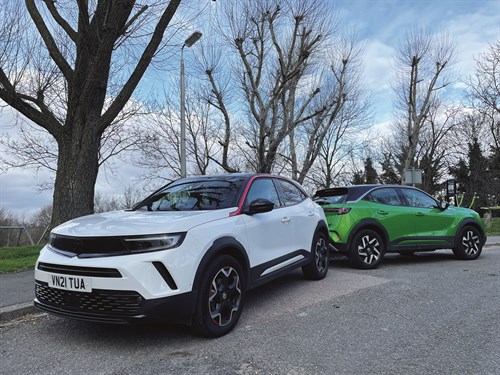
But the biggest differences come in measuring costs. Comparisons of any EV to their petrol equivalent can be distilled down to saying that EVs cost more to buy, while petrol cars cost more to run. But drilling down into the detail of that truism is tricky because the cost goalposts keep moving. All fuel prices (including electricity) are currently volatile due to various global political crises and even list prices change more for EVs than regular cars, due to UK government policy. Case in point, its recent reduction in Plug-in Car Grant (PiCG) to £1,500, and the threshold for when it stops to £32,000, prompted Vauxhall to reduce its EV prices by £3,000 late last year so customers could still qualify. For the Mokka-E Elite we are running that means a new £31,580 on the road price before PiCG, although we still print the original £34,525 P11d figure here, to reflect its price when we first started testing.
Consequently, our long-term Mokka-E Elite is now 'only' £4,125 more than the £27,455 petrol SRi. Can the EV's current tax breaks and lower running costs claw that money back? Old stats from Vauxhall - when fuel prices were lower and the Mokka-E's list price higher - suggest the answer is yes (at the time of writing its web calculator was not working to recheck). But on fuel alone, using rudimentary maths and specific urban scenario with higher lamp post (0.24p/kWh) electricity charges than most domestic wall boxes, the Mokka-E has only cost £232 over 3,000 miles. Meanwhile, the petrol 1.2 could cost £584 based on similar roads and a likely real-world 35mpg versus 47mpg official and £1.50 per litre price. Extrapolate that £352 difference over 30,000 miles and the EV fuel saving is £3,520. Coupled with generous tax breaks - Mokka-E's 1% BIK versus petrol Mokka's 31% via a 137g/km CO2 rating - and much lower EV servicing and maintenance costs, which according to Vauxhall gives a saving of £478 (£639 versus £1117) the EV win is clear.
The only thing that would make me seriously consider a petrol Mokka is the need to make regular 100-mile-plus round trips without reliable charging at the 'away' end (in which case I would probably choose a bigger car anyway, EV or otherwise). As it is the Mokka-E wins hands-down for this city-based use case.
6th Report: positive double-takes
Some cars attract attention for the wrong reasons. My favourite automotive anecdote of this type relates to when my other half sagely pointed out on our first outing in the then all-new, first-generation Mini Countryman, more than a decade ago, "that people look at you in it like they stare at women who they suspect of being pregnant. They scrutinise with the intensity of noticing something familiar, but bigger than they remember."
I had a similar feeling running the Fiat 500 L but the Mokka-E isn't a pumped-up anything, or indeed trying to lean too heavily on cars from its marque's back catalogue. It's just a modern, beautifully-proportioned small crossover that's making Vauxhall interesting again, even a talking point. Another more recent anecdote: standing close to the Mokka-E and minding my own business while checking out parking restrictions somewhere unfamiliar, a stranger sidles up to me and says without introduction, "quite avant garde for a Vauxhall". A slightly odd interaction, but I agree with him. Or outside my house just the other day, a neighbour calls my name and declares that his toddler grandson "just has to talk to me about that car". They both like it a lot. When prompted, the grandson smiles a big grin and says "green!" and then simply "bye" before I can continue the conversation. These are the sort of positive reactions that help anyone justify big purchases and colour choices that both - like it or not - send out a message to the world about your possible character.
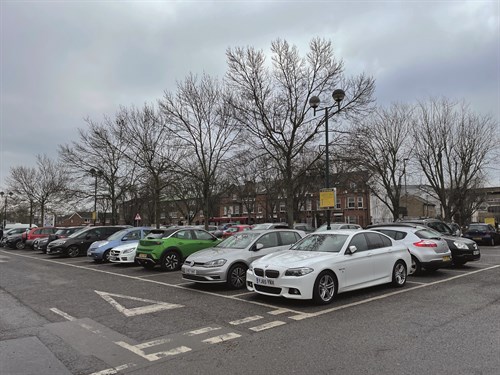
The worst that anyone's said to me about driving the Mokka-E, and with a little smirk added, is that's "it's very green". Other (less bright) Mokka colours are available. Regardless, I happen to really like the Mamba green Premium metallic paint option (£650) and especially paired with its gloss black roof. One other point to mention regarding the Mokka-E's pricing since writing our previous report: in reaction to the UK government reducing the Plug-in Car Grant (PiCG) to £1,500 and the threshold for when it stops to £32,000, Vauxhall has reduced its EV prices by £3,000 on the Mokka-E (and Corsa-E) so customers can still qualify. For the Elite model we're running that means a new £31,580 on the road price (before PiCG), although we still print the original £34,525 P11d figure in our spec sheet, based on the price of the Mokka-E when we started testing it.
In these grubby wintry months neither the Mamba green metallic nor the gloss black show up the dirt much and there's another practical perspective to this EV's appropriately symbolic green colour too. It stems from an off-the-cuff remark I made in my introductory report, but which has remained true ever since - I've never lost the Mokka-E in a car park (see picture inset for clear evidence why). The only potential downside to consider, according to ex-CAP industry veteran and now independent residual values consultant Martin Ward, is that green-coloured cars aren't always worth as much as less stand-out colours in the second-hand market. "Bright green on specialist and sporty cars like the Audi RS Q3 and new BMW M4 can equal or add value, as they're so different and have customers who often like to stand out", Ward tells Business Car, "but on more regular models like the Corsa or Mokka, it's more a case of wait and see. Generally a blue or red model will sell before a green one". That's logical enough, but maybe the Mokka-E with its electric powertrain differentiator will buck the trend. Green or indeed other bright colours aren't for everyone, but sometimes it feels good to be different.
5th Report: Gripes, we've had a few...
Although there's a lot to genuinely love about the Mokka-E - its design and all-electric feel-good factor in particular - a few of its features have been letting the side down lately. The good news is that most of those negatives appear to relate to software, which might mean they are easier to fix than a fundamental design flaw or a physical engineering problem.
The biggest issue we've encountered with this particular Mokka-E is its glitchy centre screen. On several occasions it has remained blank for longer than is customary at start-up, before slowly coming to life well after the journey is under way. More recently still, the screen went one step further and steadfastly stayed blank for the whole 20-minute journey. Luckily we knew where we were going, so we didn't need the satnav and can sort of hold a note, so we could manage without songs on the radio. But it's annoying and a bit unsettling nonetheless. On other drives, and in a similarly glitchy manner, after shifting gears from 'reverse' to 'drive', the rear-view camera has stayed on - for a considerable amount of time each time - showing a lovely view of the rapidly disappearing landscape behind the car, but of little practical use while going forwards and a bit distracting to boot. As is typical, these are intermittent rather than constant problems, so maybe not worth hauling the car into a dealership for right now, but we'll keep an eye on them.
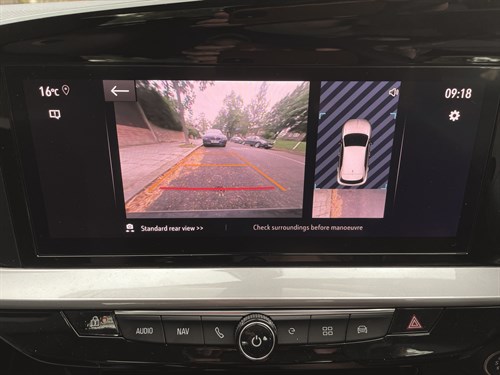
This slow-to-react tendency extends to the Mokka-E's 10in Multimedia NaviPro touchscreen capability too. Letters and numbers input on the screen often just take too long to render. This can logically make you think your latest 'touch' has not registered at all and make you re-input the same letter just as the first letter finally appears, consequently combining (and conspiring) to misspell the place you wanted directions to in the first place. So you have to start again. To be even-handed, this is a problem many carmakers' in-house systems suffer from and the antidote is to hook up your phone - for me via AppleCarPlay - which is at least easy to do and then works well. But that can sometimes mean using mobile data you don't want to use, as the car's mobile internet hotspot doesn't appear to be more than lukewarm.
There is an app for the Mokka-E to mention, which is fairly-well designed and I have downloaded to my iPhone. It passes on useful info remotely, like letting you know how many miles of range you have left, or if plugged-in and charging, how soon it should be full, but it too can be 'slow-to-react', whirring sometimes for minutes when the refresh button is pressed, before providing an update.
The only real 'hardware' issue that the Mokka-E suffers from is below-average ride quality for a small family crossover - especially over potholes and robust speed bumps. We definitely got spoiled in our previous Citroen C5 Aircross PHEV by its suspension system with 'Progressive Hydraulic Cushions', which made every surface appear smoother than it actually was. The Mokka-E's crashier ride is not a deal-breaker for me, but it's something that could do with attention for the next generation model.
One last thing, while in (minor) 'moan mode'. The cold winter weather experienced in early December appears to have hit the Mokka-E's electric range. Where similar journeys and driving styles were resulting in regular 3.5 miles per kWh figures in the warmer autumnal months, more recent trips have seen that number drop to 2.7 miles per kWh. It's a well-known truism that most EVs' economy figures aren't as good in colder environments, but it's interesting to know by how much in this case.
4th Report: A little design miracle
We called it early in our very first report on this long-termer back in September 2021: "The Mokka-E is quite possibly the most desirable Vauxhall in decades." Full-electric powertrain aside, a lot of that comes down to the model's striking exterior and interior design. That great-looking, visor-like, slim face, high-waisted and well-proportioned flanks, rakish roofline and interesting graphics all seem a world away from any other 21st century Vauxhall launched before this second-generation Mokka, and we include the squidgy and ill-defined first generation Mokka from 2012 in that list.
The transformation may appear to have happened over night, but it didn't. Keen followers of global motor shows - and concept cars in particular - may have noticed a few decent concept vehicles cropping up within the past decade from Vauxhall's sister brand Opel that subtly signalled change was afoot for both marques. The 2013 Opel Monza might have looked like a wild and sporting shooting brake with dramatic gull-wing doors and more, but it led to the sensible and handsome 2017 Vauxhall Insignia - from front face to more crisply-defined body sides.
Similarly, the 2016 Opel GT concept (pictured below) debuted as a svelte two-door sportscar - harking back in turn to the 1965 GT Experimental concept - with modern and radical body coloured silver side windows and red front tyres. But look closely and you can discern where the Mokka-E has taken influence from the 2016 concept. Look at the clamshell bonnet with front-to-back centre ridge line, the LED headlight eyebrows and even the extended roof-defining side strip - on the Opel GT concept rendered bright red, but on the Mokka-E a more sober and familiar chrome. Bonus pub fact: The look, feel and function of both vehicles was executed under the watchful eye of a UK head of design in Mark Adams, which might be a nice bonus for UK fleets to know.
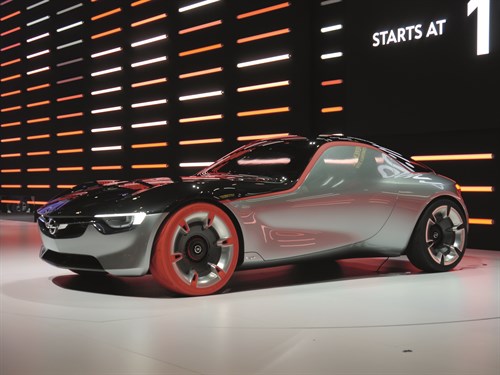
Either way, on the inside the link between the two cars is nowhere near as clear, and perhaps the lack of such a link has led to a slight 'functional ball' being dropped. While there are many pleasing design details within the Mokka-E's cabin - like the chunky gear selector toggle switch embedded into the central console area - other seemingly innocuous functional parts and their placements don't seem to work as well in practice.
Case in point, the chrome-coloured interior door handle situated above the armrest looks a normal-enough idea - especially in daylight - but at night it becomes invisible. There is no LED light surround to indicate its position and meanwhile the deeply scooped-out, concave chrome-style panel above it closer to the window catches any street light and thus appears to be the spot to grab for a quick exit. How do I know? Because I've witnessed half a dozen front passengers of mine make the same movement in vain when trying to locate the handle to open the door. Along with a boot release button that's not directly below the hatchback's lip as you'd expect, but lower and below the body-coloured area of the car within the bumper - they're two small but frustrating details in an otherwise super-smart design. And smart designs tend to be more loved by their owners, leading to better care taken of them and better residual values upon resale too.
3rd Report: Long EV road trip... yikes!
I'm not going to lie. There were a few moments in the week before embarking on my recent 180-mile one-way half-term holiday mission to the edge of the Peak District, when I seriously considered trying to swap my 200-mile electric Mokka-E for almost anything else, and probably petrol or diesel-powered.
A cursory glance at zap-map.com - the mainly very good website that shows not only where EV charging points are, but also whether they are being used right now and/or have recently suffered any faults - revealed that although there were quite a few rapid (43kW or higher) public chargers on our proposed mainly-M1 route, in many of those locations there was only one rapid charger to aim for, which made for a gamble I didn't fancy.
However, partly due to a lack of ICE test car options at short notice and because I really did want to evaluate this EV's capabilities further afield, I looked again and started a new strategy: seeking out charging locations with more than one rapid charger and slightly off main motorways. After identifying an Instavolt site with two bays and two rapid 50kW chargers, two-thirds of the way along my journey, I ended up at a KFC drive-through on the inner Derby ring road. A Zinger Tower meal later, and after 55 minutes, we were back to a 94% charge and well within striking distance of our outward destination.
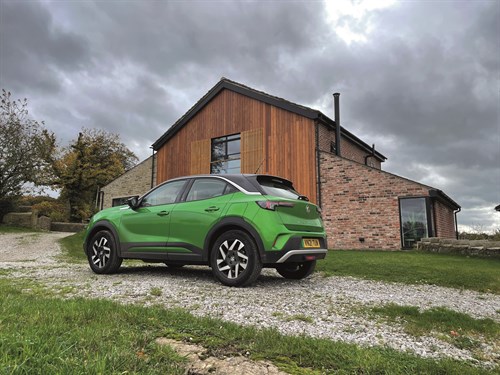
With plenty of miles spare for our first mission a few days later, this was the 'away win' required, as our Airbnb didn't have a wall box charger and was fairly remote itself. After familiarising myself with the local area and learning at almost all times to drive each journey with the B button (for brake regen) pressed, eco drive mode selected and only to go above 60mph in extreme circumstances, the WLTP range quickly matched real-world figures. That's something in 25 years of testing I've never been able to say about a petrol or diesel car. Of course, driving every day like you're competing in an MPG marathon becomes something of an imperative if you know that recharging options are scarce and possibly busy. I soon adjusted to most motorway traffic streaming past me as I spent the majority of my time in the slow lane. Not feeling like you have to keep up with the racers, or indeed having one bother you from behind in the fast lane, can make for a more relaxing drive too. When you do stop you have to take a proper break and even if rapid chargers sometimes cost 40p per kilowatt hour - I'm talking to you Instavolt and BP - a £13-15 'fill-up' is still super-low compared with the whopping £1.50 per litre diesel prices I saw in some cases.
Back to the car itself, the modest seats-up 310-litre boot space needed a little strategy to carry a family of four's luggage for a week, but by placing the load floor at the lower height, leaving the tonneau cover at home (along with too many needless changes of clothes) and stowing a few items in the middle back seat between the kids, it all fitted in. The UK could definitely do with many, many more public sites with multiple rapid chargers at each one, to get from tokenistic to realistic - as EVs will soon become - but meantime, driving an EV for 600 miles in one week to fairly remote parts of the UK proved possible. It does bring an element of 'adventure' back to motoring that requires careful forward-planning, but given the environmental upside and the current state of the world, I'm more than happy to take that on.
2nd Report: Plugging vs pumping
It's a topsy-turvy world as I write, when EV drivers can sit relatively pretty while those driving petrol and diesel vehicles suffer range anxiety - wondering where their next fill-up will come from - as UK petrol stations run dry through a lack of HGV drivers to deliver fuel to forecourts. I sincerely hope that by the time of publication, the current fuel shortage will have been resolved - by the army or some other means - but the whole debacle has shone a worrying light on how fragile the UK's fuel distribution network seems to be in late 2021.
And, while right now having a fully-electric vehicle appears to be a better choice than ever, I am resisting feelings of smugness. Because those without off-street parking like me still have to forage for fuel sometimes. Indeed, given the diversity of local charging options available, I've long learned to be strategic and focused when locating chargers and timing plug-ins. My nearest charger is less than 50 metres from my front door, but it is of the lamp-post variety without a designated EV bay marked on the road surface. That means it's effectively just another free parking space, so a car-sized position either in front or behind the lamp post must be secured - which is no easy task on a well-populated residential London street. When you catch the location empty - or sometimes ask a friendly neighbour to swap your vehicle for theirs - the 5kW charging can take a very long time (18-19 hours) to ensure a full charge from almost empty. Still, if you know you're not going to need the car from late afternoon to early the next day - a scenario that is often the case for me as I don't have a daily commute - that length of charge is fine. And it's great to have a plug-in so local with a decent for public charging, 24p per kilowatt/hour via Ubitricity. My last fill-up cost £8.37.
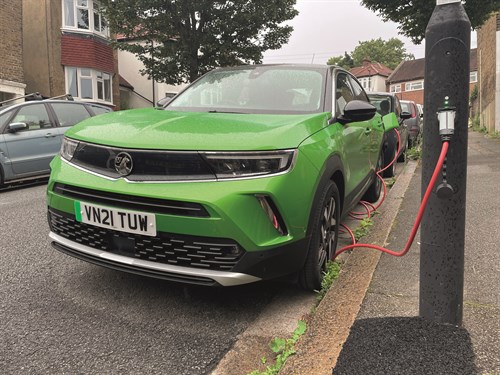
Failing that, two 50kW chargers and one 43kW version, all from the same post, are available within half a mile of my house and do a much quicker job, although that provider (ESB) charges more for the privilege, at 29p per kWh. This site usefully has a designated EV parking bay - but there is only one - and it is well-used by minicabs, and more and limited to a one-hour stay, so depending on how much charge is left before you start, getting to 80% within that 60 minutes is likely to be the max result. Again, timing your run is crucial, but with almost real-time info from Zap-Map's website or indeed the ESB app, it's quite achievable.
One really helpful - but perhaps not always considered - spec detail of the Mokka-E is its generously long recharging cable. Unlike other recent test cars - notably the past two PHEVs I've driven long-term from Citroen and Volvo - the Mokka-E's six-metre-plus cable makes it refreshingly easy to plug in, even if you can't park in the optimal position of fuel flap kerbside and close to the lamp-post charger. To avoid trip hazards, any spare cable length can be tucked between the car's wheelbase while charging and wound into its own carry case when done. The latter process can be a bit fiddly as the case only just swallows the huge and curly cable and the case itself does impinge on the modest 310-litre luggage space somewhat. But, as already mentioned, the boot floor has two height options, so you can either lower the floor for more load height and sit the case on top, or set the floor higher and hide the case underneath for neatness. Either way, the Mokka-E isn't for major load-lugging, Vauxhall has bigger cars and vans for that. And right now, we're super glad it's fully-electric.
1st Report: Mokka-chocka full
First things first: I believe the Mokka-E is quite possibly the most desirable Vauxhall in decades. From its strong design - with that great-looking, visor-like slim face and well-proportioned flanks - to its full-electric powertrain, it's a very appealing package, and one which has much to commend it to businesses too. These strong twin starting assets should translate to a) greater used demand and, therefore, improved higher residual values and lease rates for the fleet manager and b) super-low BIK (1% this tax year, 2% next) plus good-value running costs for the business driver.
At 4,151mm long, 1,791mm wide and 1,531mm high, the Mokka-E sits firmly in the small crossover segment. To give some perspective, that's 41mm longer than the petrol-powered VW T-Cross (4,110mm) and 44mm shorter than the all-electric Kia e-Soul (4,195mm). The Mokka-E's modest length translates to easy city street parking, but its narrower width and lower height also mean a slightly pokey rear passenger space, especially for the head and elbows, which my tall, 5ft 8in road-testing teenage daughters have already vocalised. Still, that is far from a deal breaker for our family of four's normally short-haul needs and quite suitable for those with younger (and shorter) kids, young couples, empty-nesters, or solo business drivers. Boot space ranges from a fairly small 310 litres with seats up to a decent 1,060 litres seats down. The boot floor also has two height options - we've already moved to the lower one.
In metallic Mamba green with a gloss black roof, this particular Mokka-E feels like a real statement to drive too. You rarely lose it in a car park and recently I've found myself waving at other bright green cars on the road - when safe to do so - and have had a 100% positive response rate so far. I don't do that in other cars. Weird habit-forming aside, that green colour is also apposite given the Mokka-E's zero-emission-in-use, eco-aiming, full-electric powertrain. The 136hp (100kW) motor affords instant and linear power from its single-gear automatic transmission. This can be fun and often helpful too, when needing to get away from bunched-up traffic situations for instance. The official 0-60mph is 8.7 seconds, but it feels faster. Using that power is simple. Just put the 'toggle-switch' gear lever into D and go, and if you want more regenerative braking to divert power back into the 50kWh battery, press the separate B button too, situated just behind. For city driving, having the B button pressed down and drive mode set to Eco feels like the best standard option. That way the 201-mile range can be well preserved, and encourages one-pedal, anticipatory cruising mode driving, rather than accelerating fast between traffic lights.
Recharging has been fine so far, and so much more rewarding after each plug-in manoeuvre than with a PHEV's limited returns. No range anxiety has yet been experienced, despite an early 120-mile round trip to Brighton, where the greater concern was the keen neighbourhood parking wardens patrolling the seaside city. Finally, standard kit on the Elite Nav Premium trim is good, with a strong set of safety items (see separate box) and little extra kit specified. Just Premium metallic paint (£650) and IntelliLux Matrix LED headlights with advanced forward lighting (£700) are extras on our model. In summary, I'm genuinely excited at the prospect of driving this Mokka-E in the coming months and looking forward to explaining more about its attributes.
Standard equipment on Elite Nav Premium Auto:
Active Driver Assist Plus with driver drowsiness and forward collision alert, automatic emergency city braking, adaptive cruise control, lane positioning assistant, Vauxhall Connect with e-call, front and rear parking distance sensors, panoramic rear-view camera, speed sign recognition, keyless entry and start, tyre pressure monitoring system, side blind spot alert and flank guard, hill start assist, 12in digital driver display, 10in colour central touchscreen with sat-nav, DAB radio, voice-activated control, Bluetooth, DAB, 18in bi-colour alloys, black roof.
Optional equipment (£1350):
Premium metallic paint (£650), IntelliLux Matrix LED headlights with advanced forward
lighting (£700)











